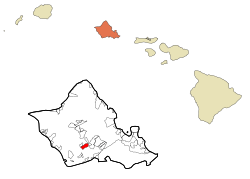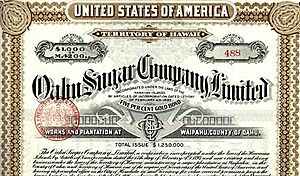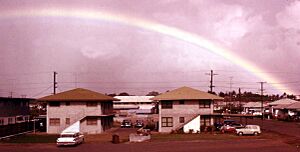Waipahu, Hawaii facts for kids
Quick facts for kids
Waipahu
|
|
|---|---|

Location in Honolulu County and the state of Hawaii
|
|
| Country | |
| State | |
| County | Honolulu |
| Area | |
| • Total | 2.80 sq mi (7.25 km2) |
| • Land | 2.68 sq mi (6.94 km2) |
| • Water | 0.12 sq mi (0.31 km2) |
| Elevation | 62 ft (19 m) |
| Population
(2020)
|
|
| • Total | 43,485 |
| • Density | 16,237.86/sq mi (6,269.45/km2) |
| Time zone | UTC−10 (Hawaii-Aleutian) |
| ZIP code |
96797
|
| Area code(s) | 808 |
| FIPS code | 15-79700 |
| GNIS feature ID | 0364878 |
Waipahu (Hawaiian pronunciation: [vɐjˈpɐhu]) is a town in Hawaii with a rich history. It used to be a big sugarcane plantation town. Today, it's a census-designated place (CDP) in the ʻEwa District on the island of Oʻahu. Waipahu is part of the City & County of Honolulu. In 2020, about 43,485 people lived here. The postal code for Waipahu is 96797.
Contents
- Discovering Waipahu's Past
- Exploring Waipahu's Geography
- People of Waipahu
- Schools in Waipahu
- Notable People from Waipahu
- Images for kids
- See also
Discovering Waipahu's Past
What Does Waipahu Mean?
The name Waipahu comes from a special artesian spring. In the Hawaiian language, wai means water. Pahū means "burst or explode." So, Waipahu means "water forced up (like from a spring)." Early Native Hawaiians loved the cool, clear water from this spring. They named the spring Waipahu because of how the water gushed out.
Waipahu as an Early Capital
Before Western people came to Hawaii, Waipahu was very important. It was even considered the capital of Oahu. Hawaiian royalty often gathered here. They enjoyed the fresh water from the Waipahu spring.
The Sugar Plantation Era
In 1897, the Oahu Sugar Company started. They built their sugar mill in Waipahu. This company was a huge part of the town's history.
Workers from Around the World
The sugar company needed many workers. They brought people from different countries. These included the Philippines, Japan, China, Portugal, and Norway. Most of the first workers were from Japan or China. Very few Hawaiian people worked for the company.
Workers lived by something called "The Plantation System." Field workers earned about $12.50 a month. Filipino workers were often paid less, sometimes under $10.00 a month. Chinese workers usually earned the most, around $15.00 a month.
Learning Opportunities for Workers
In 1932, the Oahu Sugar Company opened a special school. It was called a continuation school. Workers could take half a day off work once a week to attend. Evening classes were also available. This helped workers learn new skills for better jobs.
Waipahu During World War II
On December 7, 1941, Imperial Japanese Navy planes attacked Pearl Harbor. During this surprise attack, planes also fired at the sugar mill in Waipahu. One civilian was killed, and seven others were hurt.
End of the Sugar Era
The Oahu Sugar Company was bought by Amfac in 1961. The plantation stopped its operations after the 1995 harvest. This marked the end of a long sugar-growing history in Waipahu.
Sports and Community at Hans L'Orange Field
In 1923, the Oahu Sugar Company's field was a community hub. It hosted band concerts, sports events, and carnivals. Later, this athletic field was named Hans L'Orange Field. Today, it's mainly used for baseball. It's the home field for Hawaii Pacific University's men's baseball team.
Hawai'i Plantation Village: A Living Museum
In 1973, land was bought to create the Waipahu Cultural and Garden Park. This park is now known as the Hawai'i Plantation Village. It's a living history museum in Waipahu.
What You Can See at the Village
The museum shows what life was like for Hawaii's plantation workers. It opened in 1992. You can see original buildings and replica homes. These homes show how different ethnic groups lived. These groups came to Hawaii between the mid-1800s and the 1940s. They came to work as plantation laborers. Guided tours are available Monday through Saturday.
Celebrating Waipahu's Centennial
In 1997, the Governor of Hawaii, Benjamin J. Cayetano, declared a special celebration. June to November 1997 were "Waipahu Centennial Celebration Months." Many events were held to celebrate Waipahu's 100th anniversary.
Little League Champions
Waipahu is home to the 2008 Little League World Series champions! The team was from Waipi'o Little League. They won the final game on August 24, 2008. In 2010, the same team won the U.S. championship again.
Exploring Waipahu's Geography
Waipahu is located along the northern shore of Pearl Harbor. Specifically, it's near Middle Loch and West Loch. Two main roads, Interstate H-1 and Farrington Highway (Hawaii Route 90), run through Waipahu.
Land Divisions and Neighborhoods
The town of Waipahu covers three ahupuaʻa. These are old Native Hawaiian land divisions. Their names are Waipiʻo, Waikele, and Hōʻaeʻae. Many neighborhoods in Waipahu are named after these historic land areas.
Some nearby areas also use Waipahu as their postal city. These include Waipio, Village Park, Royal Kunia, and Waikele. People often think of them as part of Waipahu.
Natural Features
Several streams flow through Waipahu. These include Waikele Stream and Kapakahi Stream. Waikele Stream runs by the Hawaii Plantation Village. It then flows into the Pouhala Marsh Wildlife Sanctuary. This marsh is home to several rare bird species found only in Hawaii.
The land in Waipahu changes in height. There is about 140 feet of elevation change. This is between the north side of Waipahu near H-1 and sea level.
Connecting Roads and Nearby Towns
Waikele is located north of Waipahu, across the H1 freeway. Waikele has newer homes and a large shopping center. It also has a famous golf course.
To the west of Waipahu, you can reach Makakilo and Kapolei. To the east are Pearl City and the H-2 interchange to Waipiʻo.
Kunia Road (State Rte. 750) is at the western end of Waipahu. It leads to newer areas like Royal Kunia and Village Park. It also goes north to Kunia and military bases like Schofield Barracks. South of Farrington Highway, Kunia Road becomes Fort Weaver Road (State Rte. 76). This road goes south through Honouliuli and ʻEwa Villages to ʻEwa Beach.
The total area of Waipahu is about 7.2 square kilometers (2.8 square miles). All of this area is land.
People of Waipahu
| Historical population | |||
|---|---|---|---|
| Census | Pop. | %± | |
| 2020 | 43,485 | — | |
| U.S. Decennial Census | |||
In 2000, there were 33,108 people living in Waipahu. There were 7,566 households. The population density was about 12,882.8 people per square mile.
Diverse Community
Waipahu has a very diverse population. In 2000, about 67.1% of residents were Asian. A large part of this group, 55.5%, were Filipino. About 12.31% were Pacific Islander. Other groups included White (4.73%) and African American (0.93%). Many people were from two or more races (15.26%). About 6.09% of the population was Hispanic or Latino.
Households and Families
About 36.2% of households had children under 18. Most households (59.8%) were married couples living together. The average household had 4.23 people. The average family had 4.37 people.
Age and Income
The population in Waipahu is spread across different age groups. About 26.4% were under 18. The median age was 36 years old.
The median income for a household in Waipahu was $49,444. For a family, it was $51,855. The average income per person was $14,484. About 13.8% of the population lived below the poverty line.
Education Levels
In 2000, about 68.6% of people in Waipahu had a high school diploma. This is lower than the national average of 80.40%. About 11.1% of the population had a bachelor's degree or higher. The national average for this was 24.40%.
Schools in Waipahu
The Hawaii Department of Education manages the public schools in Waipahu.
Elementary Schools
Elementary schools within Waipahu include August Ahrens, Honowai, and Waipahu Elementary. Two other elementary schools, Kale'iopu'u and Waikele, use Waipahu addresses. However, they are located in nearby areas.
Intermediate and High Schools
Waipahu Intermediate School and Waipahu High School are both located in the CDP. Some students in Waipahu attend Waipahu High School. Others attend Pearl City High School.
Lanakila Baptist School, a private school, also has its elementary school building in Waipahu.
Notable People from Waipahu
Many interesting people have connections to Waipahu:
- Danny Barcelona: A famous drummer for Louis Armstrong's All-Star Band. He was born in Waipahu.
- Kirk Caldwell: An American politician who became the Mayor of Honolulu. He was born in Waipahu.
- Timmy Chang: A professional football player and current NCAA coach. He was born in Waipahu.
- Brian Viloria: A professional boxer who won world championships.
- Jerome Williams: A professional baseball pitcher. He graduated from Waipahu High School in 1999.
- Victoria Lee: A mixed martial arts fighter for One Championship.
Images for kids
See also
 In Spanish: Waipahu para niños
In Spanish: Waipahu para niños





